Menus
- 197 hp at 9,500 rpm, 155 Nm at 7,200 rpm, 3 engine maps, 300 km / h, € 15,499
- Cut for speed, does the myth stand up to the ravages of time? ?
- Discovery
- In the saddle
- In the city
- On motorways and main roads
- On departmental
- Part-cycle
- Brakes
- Comfort and duo
- Consumption / Autonomy
- Conclusion
197 hp at 9,500 rpm, 155 Nm at 7,200 rpm, 3 engine maps, 300 km / h, € 15,499
Cut for speed, does the myth stand up to the ravages of time? ?
Thursday 11 February 1999. A big number crosses the front page of Moto Journal n ° 1362: 340 ! He covers a Suzuki Hayabusa with a driver in a leather suit and in the speed search position. This phantasmagorical figure could only capture the minds of bikers: while being irrational and paradoxically quite accessible (it was then sold for 75,000 francs, the equivalent of € 11,434 at the time, or even € 14,550 today if the ‘we reason in terms of constant purchasing power according to INSEE), this machine represented a mixture of dreams and emotion, transgression and symbol. And also, incidentally, enough to suck the supercar of the time, the Lamborghini Diablo GT. At the time, I bought this magazine with a mixture of bewilderment and disbelief; however, I was a student and I drove in Kawasaki ZX-7R (unbridled, it is bad, but there is prescription), it was already not calf slack. But there, the Suzuki crossed a milestone: 175 horsepower in free version and 340 counter in top speed, as Moto Journal claimed. Without realizing it, those fascinated by this motorcycle were probably deranged and criminogenic spirits, only good to be interned in Guant.ánamo.

Because there was a second Kiss Cool effect© : scandal under the gold of the Republic! At the Ministry of the Interior, the Road Safety Division is surprised in its routine, the purring echo of which dilutes in a throbbing manner in the thickness of the felted carpet and borders on the rupture of the collective aneurysm (this would have been a first in the annals of Occupational Medicine). The phones start ringing all over the place. At Suzuki France, we keep a low profile (while laughing in his mustaches, because the 800 copies planned for France will sell without requiring a single ad page). Behind the scenes, the ball of false asses began: the union chamber of the small world of motorcycles is rampant and deprives the then weekly of advertising revenue for a month as well as test motorcycles. Financially, it’s hard, but MJ will get closer to his readers who will lend their own motorcycles: solidarity, a safe bet.
In 1999, there were still more than 8,000 deaths on the roads of France, almost two and a half times more than today. Yet security policy had not become a more sacred subject than the condition of the cows in India, and roadside racketeering was not yet an exact science..
We can therefore imagine the impact that such a MJ front page would have today. Would it even be possible? And yet, 17 years after the fact, the Suzuki Hayabusa is still there, almost unchanged and still as powerful as ever. With one nuance: in a nice effort of tartufferie in order not to offend sensitive souls, the graduations of the meter are not explicit beyond the number "280", but at the same time, the bike went from 175 to 197 horses at the arrival of the second generation of the model, in 2008 and the passage of the engine from 1299 to 1340 cm3.
17 years of existence is almost a record for a motorcycle model which has, moreover, changed very little. This longevity is easily explained: the Hayabusa instantly became a planetary myth. With its 300 km / h chrono (the odometer cheated a little, MJ subtly played on this ambiguity), the Hayabusa was quite simply the fastest production motorcycle of the 20th century. Proof, if it were needed, that in the world of motorcycles, performance … or dreams are sellers: the Kawasaki H2 is here to remind us today.

Recall that at its launch, the fastest road then was the Honda CBR 1100 XX called "Blackbird", given for a little over 280 km / h chrono. The Hayabusa (the name means "peregrine falcon" in Japanese) was named so because the falcon is a predator of the black bird..
With the Hayabusa, Suzuki did not only mark the spirits: the brand also opened the cash drawer: the first generation (1999-2007) having sold more than 100,000 copies. All over the world, she responded to bikers who were looking for a fast, statutory machine (even today it’s astonishing how it impresses when it gets somewhere), and, as that wasn’t enough, states – United with South Africa, many preparers have stuck turbos to it: the engine block is indeed almost indestructible and can output 340 horsepower while maintaining excellent reliability. And while our pandores rode Yamaha TDM 900s, the Oklahoma police built a rapid response force with black Hayabusa !
Thanks to the retrofit, justice can be done again, French bikers are no longer considered primitive and immature beings and we were finally looking forward to discovering the myth in all its potential. Will the legend suffer from the reality check ?

Discovery
The Hayabusa does not leave you indifferent. Those who do not know it tick on its generous size and aerodynamic shapes. Others, bikers or motorists, look at you with a touch of respect. In two decades, the laws of aerodynamics have not changed much and the Hayabusa is not lying about its vocation: with its tapered shapes, its enveloping fairing, it is cut for speed..
Its forms, due to the designer Koji Yoshiura, have therefore become familiar to us and the Hayabusa is sufficiently installed in the motorcycle world so that we no longer discuss whether it is beautiful or not, or even that it evokes the Munch’s "scream", in a way. The shape of its optics, of its seat backrest are unique and contribute to its identity. From the front, pot-bellied and profiled, we only notice its generous air inlets.
The Hayabusa today is version 2.2: the main dates of its evolution are indeed 1999, 2008 and 2013, where this second generation is refined by acquiring an ABS and pretty Brembo front brake calipers.
Note that our test machine was equipped with the optional Yoshimura mufflers. They are no longer available as accessories from Suzuki, but are distributed by Bihr and are worth around € 800.
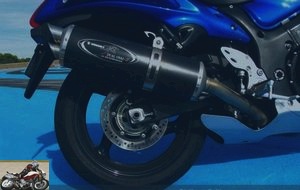
In the saddle
Long and wide, the Hayabusa puts its saddle at a reasonable 805 mm of altitude which may suit most, but it will be necessary to deal with a prominent tank and handlebars placed rather low. The driving position is undeniably sporty, calculated to hurtle down the Autobahn in speed-seeking posture. For everyday life, obviously, we made more versatile! With 262 kilos fully packed, it requires a little attention when maneuvering at a standstill, even if its weight is generally forgotten while driving..
However, the saddle is distinguished by its generous shapes, all the controls are very smooth, the controls are logical in their handling (and we note the presence of the S-DMS "mode" button on the right, which allows you to select one of the three engine maps). The large dashboard uses five dials, including a digital one, in the center, where the gear indicator appears. Everything is extremely clear and readable.
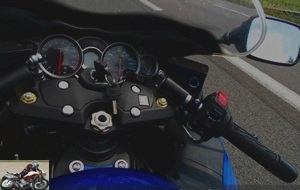
As on all Suzuki, you have to disengage to start: the big 4 cylinders come to life in the very (too!) Muffled sound of the optional Yoshimura, yet impressive by their visual presence..
In the city
Despite the somewhat distinctive driving position which will not bother all those with a sporting soul, the Hayabusa does not fare too badly in the urban trap. The machine is perfectly well balanced and its four cylinders is absolutely remarkable flexibility, able to resume on the idle speed in third or to make the scooter in sixth from 1500 rpm. In difficult conditions (cobblestones, wet pavement …), those whom such a monster would intimidate in the absence of traction control can select the "C" mode of the mapping: the engine response is then much smoother..
The mirrors are quite large and pile on the level of those of the cars. On the other hand, even in high temperatures, the Hayabusa does not overheat and does not spend its life evacuating calories with the fan in agony while cooking your gonads. A good point, that…
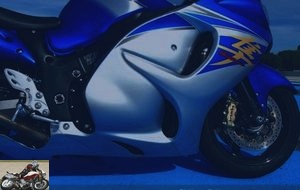
On motorways and main roads
Did you like the bridled Hayabusa? Then you are going to love the liberated Hayabusa! Because in fact, on the highway, it’s the same! Because if our free version comes out 197 hp at 9500 rpm and 155 Nm of torque at 7200 rpm, the restricted version delivered 106 hp at 8900 rpm and 130 Nm at 4700 rpm. For having tried the two versions, the difference is especially noticeable above 7000 rpm.
The problem is that at 7000 rpm in sixth, the Hayabusa traces its course at a small 210 km / h cruising, still 4000 rpm away from the red zone. Quiet, what.
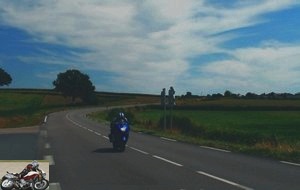
As a good perricho-responsible citizen, you will stick to a wiser 4500 rpm, at 130 km / h, therefore. Even at this legal speed, it will take a bit of hunchback to feel well protected. Of course, whether in a straight line or in large curves, the stability is totally impeccable..
The challenge that the Hayabusa poses on highways, it lies in the mind of its pilot: who has the strength and wisdom not to exceed 4500 rpm, when the slightest rotation of the throttle propels you in a moment, under the effect of the generous torque and the good-natured character of the big four legs in mid-revs, at already reprehensible speeds? Huh, who? And who will be able to resist the temptation to test the rigidity of this famous chassis, in the series of large curves that arise? Keep weak souls away from temptation, Hayabusa !
On departmental
The Hayabusa reveals two different personalities depending on the profile of the road: on a relatively fast and regular course, it seduces by the frankness of its front axle, its excellent stability and the copious revivals of its engine which, seemingly nothing, deposits anyway seriously, with a large sensitive torque from 4000 rpm, the cavalry, it landed at 7000. But given the length of the beast, in the gorges of the Verdon or the Ardèche, these are engine speeds that you will not have the opportunity to frequent often.
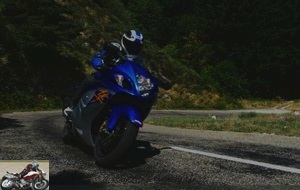
Because, when the road becomes more tortuous or when the rhythm increases, the Hayabusa can neither deny his age nor his vocation. Its wheelbase of 1480 mm does not make it particularly agile in the tight turns that one negotiates in second or third and it will then be necessary to work a little on the handlebars and the footrests to register the bike in curves. And on the attack, it wiggles a bit on the suspensions, while with the big potato available, no traction control and old tires (Bridgestone BT-015), we keep a little on hand; if the front axle remains healthy, it is especially the rear which often slips when the couple arrives. Nevertheless: the big Suzuki is not doing so badly, we just have to remember that in its specifications, the German motorway was placed a few notches higher than the departmental gravelled Morvandaise (pleonasm). Note, however, that even under heavy acceleration on a bumpy wheel, the front axle is imperturbable. And if necessary, a steering damper keeps watch.
Part-cycle
There is classic and proven on this Hayabusa: a large perimeter aluminum frame, connected to a Kayaba inverted fork 43 mm in diameter and fully adjustable, as well as a single shock absorber, also fully adjustable, to the back. The front tire is a classic 120/70 x 17; to pass the power, Suzuki chose a 190/50 x 17 at the rear; a 200 would probably have penalized agility too much.
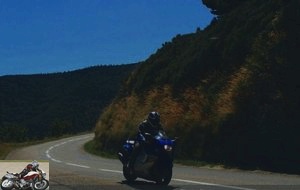
Brakes
Installing one-piece Brembo calipers on 310mm discs is a great idea! Ruined, unfortunately by maintaining conventional hoses and a master cylinder from an old stock from Suzuki. Suddenly, not only is the typical Brembo bite lacking, but the braking power is even a little tight in absolute terms, especially given the weight of the machine and its ability to relaunch! When you arrive quickly, you have to be able to brake hard. ABS has a good habit of not triggering unexpectedly, but its control unit is not one of the latest generations..
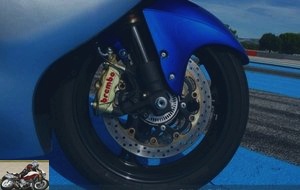
Comfort and duo
It’s a bit of a rolling paradox, this Hayabusa! Because the typical driving position can tire in the long run and the limited protection encourages you to give up your hand. Yet what a great rolling machine! Between the inexhaustible breath of the engine, the good handling of the suspensions, the large and generous saddles, the general approval, it makes you want to cut down kilometers, preferably on winding routes, but fast at the same time: the big curve, it’s definitely his thing !
Designed for speed and extracting large amounts of heat, its low-cut fairing has the good taste of not turning it into a pressure cooker, even in high heat. That too is part of the comfort. Too bad, therefore, that there are some vibrations in the handlebars.
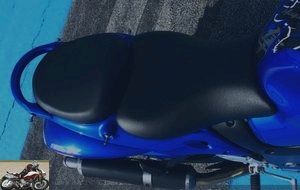
Consumption / Autonomy
The advantage of good aero and a torquey engine that already gives a lot in low revs, is that it limits consumption. Even more with a gear reduction cut out for speed and which gives fairly low rotation speeds (3100 rpm at 90 km / h in sixth). Suddenly, with its 21 liters in the tank, the Hayabusa is cut for long distances.
At 130 km / h on the French motorway, you will make a small 5.5 l / 100. In Germany, at 160/170 km / h cruising, which remains very reasonable, the Hayabusa consumes only 5.8 l / 100. On a small departmental road solo, I made 6.5 l / 100 and 5.7 l / 100 during the ascent of France by the small roads in duo. Finally, two days in Paris and its suburbs: 6.2 l / 100. Considering the performance, it is very correct and the autonomy exceeds 350 kilometers for a ride..
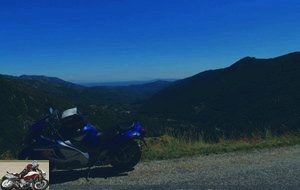
Conclusion
So, this myth? I’ll tell you a secret: I went to get the Hayabusa in the continuity of testing the Kawasaki H2 and ZX-10R in full power. And the first kilometers are a bit of a disappointment: the big 4-cylinder is very flexible and has a lot of reach, but in usual speeds, it’s a bit Casimir, the kind monster. Where the ZX-10R gives you the feeling of riding a fighter plane and the H2 makes you think of a rocket that you would get caught in the rear end, the Hayabusa is more like the Airbus A380 at the take-off: sustained power and big, big reach, which never seems to stop, but no brutality. And that’s it, an A380 taking off! Like what, there are many ways to take 200 horsepower in the foundation.
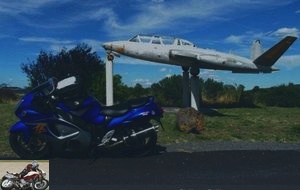
Historians will remember that Hayabusa came with the end of an era: when speed was still socially accepted as a vector of progress. How far are the days when Citroën made its cars take off from an aircraft carrier and still further (very fortunately), when liqueur manufacturers (Cointreau …) recommended that you take "a little last for the road". All of this is the past century and the Hayabusa arrived at the turn of this century.
Its design dates back almost 20 years and, of course, it is a little overwhelmed by the bite of its braking, its lack of electronic assistance worthy of the name, its average agility and the rigor of its suspensions in the attack. Nevertheless: if the myth has crossed the years as well, it is because the Hayabusa remains a docile machine while being capable of performances which are still exceptional, even in the 2016 scale. Although its driving position either typed, it remains rather comfortable overall for a sporting motorcycle. And, above all, the Hayabusa is a formidable fast road, able to swallow straight lines and big curves at truly indecent speeds, with ease and in complete safety. She is the worthy heir to the spirit of Gran Turismo, from the days of those fast and relatively comfortable Italian coupes, but which only had ridiculous luggage compartments, barely good for crossing Europe in a weekend. with a fuck-in-town close at hand. But times have changed: where to ride like this today ?
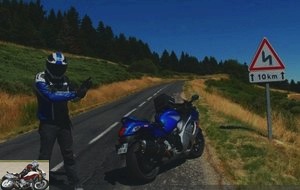
In this sense, the Hayabusa looks a bit like a dinosaur. A good big dinosaur, rather nice and helpful. There is no contraindication to loving dinos: moreover, the Jurassic Park saga has been a hit.
Strong points
- Mythical motorcycle !
- Smooth, powerful, torquey motor, full of reach
- Suspension comfort
- Fast curve stability
- Precise front axle
- Good fast road
- Consumption / autonomy
- Pilot and passenger comfort
Weak points
- Average braking
- Medium agility
- Where to use it fully ?
- No traction control
- Strict suspensions on small attacking roads
- Typical driving position in the long run
- Quite shy Yoshimura sound
- Vibrations in the handlebars
- Old tires (Bridgestone BT 015) outdated
Suzuki Hayabusa technical sheet
Test conditions
- Itinerary: 2300 km in 8 days with two days of use in Paris, a descent to Castellet by motorway in solo and a return by the small roads (Verdon, Barronies, Ardèche, Auvergne, Morvan) in duo.
- Motorcycle mileage: 2000 km
- Problem encountered: followed with insistence by two police officers in FJR in the surroundings of Lyon. They had to watch for the excessive speeding. Alas, I am an exemplary biker. Missed again, Callaghan !
- The competition: BMW K 1300 S, Honda VFR 1200, Kawasaki ZZR 1400, the TGV, a Lamborghini Diablo
- All Suzuki tests
- All road tests
Related articles
-
In-line twin, 248 cm3, 25 hp at 8000 rpm, 23.4 Nm at 6500 rpm, 188 kilos, € 5,749 A small road trail in the tradition of the V-Strom family Fifteen….
-
The mid-size trail passes Euro 4 standards: 645 cm3, 71 hp and 62 Nm, 216 kilos, € 8,899 A simple, accessible, versatile and efficient motorcycle For 7…
-
Single cylinder, 4-stroke, 124 cc, 15 hp, 133 kilos, from € 4,099 A stylish and sporty little roadster for young people or beginners The roadsters being…
-
Single cylinder, 4-stroke, 124.4 cm3, 15 hp at 10,000 rpm, 11.5 Nm at 8,000 rpm, 134 kilos, € 4,599 A little sportswoman who worthily represents the…
-
Suzuki Hayabusa motorcycle test
High speed phoenix (valid for its tester after a high-side) 4 cylinders in line, 1,340 cm3, 190 hp, 150 Nm, 264 kg, Euro5, 18,499 euros Hayabusa…. this…
-
Wes Cooley Replica or GS 1000 shake It was nicknamed Wes Cooley Replica , from the name of the American rider who, at the helm of a machine of similar…
-
60,000 km in Suzuki Bandit 600S model 1999 When we speak of Suzuki Bandit, we no longer speak of a motorcycle but of a phenomenon. Because at the time of…
-
Japanese legend, successor to the GSX1100S Katana 4 cylinders in line, 999 cm3, 150 hp, 108 Nm, 215 kg full made, 13,699 euros The Katana is a very old…
-
Suzuki GSR 750 motorcycle test
The way of the Samurai Following an almost Darwinian principle, motorcycle models are constantly evolving and by period. Thus, the era of the 600cc…
-
The handyman The Suzuki GS 500 is the queen of motorcycle schools: a twin-cylinder of 500 puncture-proof cc at a minimum price, launched in 1989, and…
Silly question: it would not duplicate the range with the Thruxton 1200?
good already on photo n3 they turned the radiator protection grid to believe that it cost them a kidney.
on mine by changing the pots from ironheads from ixil
They have already fallen to less than 7 kilos on the pair, which is the cause of all
homologated version with baffle with modification of the baffles, kn filter
refinement of cartho sport mode its cause !! The non-adjustable inverted under leg reminds me of the same under leg which was on the first mt09 which were merguez, the two rears are the same except for the color, apart against as quoted above when they do not have a gnat size like me 90 kl well we change the fork oil and a
the rear preload on 4 and the turns and play! braking question
already the brembos his strong plant with two fingers, m50s on this kind of machine does not squeeze much! except to say that j is a big pair !!!! let’s talk about the hp piston engine it already had lightening moving parts too -17% for me 17% less reliability over time with the terminals in addition with the euro 5 standard the finger catalyst
to be very strong.
The previous one was prettier
with its classic fork which should have been improved as well as the Ar.idem shock absorbers for the engine which is deprived of the 5cv of the truxton …. all this to read at the end That a nine t has more character!
I will wait for version 2222 or 2233 …
I only see the RS at Thruxton … and that worries me a bit, because that would mean that there will never be an "R" or "RS" in SpeedTwin ?
in any case, if they come out with one, like the Thruxton, like Showa fork and Ohlins shock absorbers all braked by Brembo like M50 (yes I know, it’s abused … or 44.3 ??? or .2 I do not know more😁) me, I’m a taker !!
I’m sure it’s already trotting in the minds of some engineers … 😜